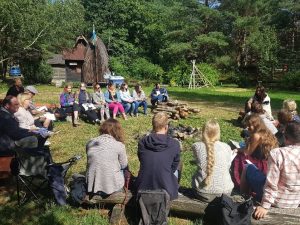Livonian
CURRENT CIRCUMSTANCES AND FUTURE CHALLENGES AND OPPORTUNITIES
As a highly endangered Finno-Ugric language, Livonian has already started down the path toward entering the digital space. A number of digital resources have been created and gradually provided to the public. Some technologies and tools like keyboard drivers (e.g., https://rootroo.com/en/livonian-keyboard/ by the Finnish company RootRoo (Hämäläinen & Alnajjar 2021)) and spellchecking software are already being used. An experiment for creating an NLP-based machine translation technology for Livonian has been carried through. This experiment was performed by the University of Tartu Institute of Computer Science Chair of Natural Language Processing (see Rikters et al. 2022).
Compared to many critically endangered languages, as a result of almost two centuries of collecting language data, Livonian is documented relatively well, especially considering its small number of speakers. This has created some preconditions for bringing Livonian into the digital space – both in terms of accessibility of the language data for better research and ensuring the overall sustainability of Livonian by improving access to language sources for the Livonian community.
There are several potential users for the resources and technologies developed for Livonian. The two main groups are (1) specialists interested in researching the Livonian language, intangible cultural heritage, and the Livonian community, and (2) speakers and those who want to study the Livonian language and culture. The needs of both groups are somewhat different; however, the two main types of technologies required by users can be identified. Users need technologies that make further expansion and processing of language resources more efficient as well as support language use and acquisition by including technologies for accessing content by those not proficient in Livonian (a majority of users).
The development of various machine translation technologies has proven efficient in languages with more speakers and greater linguistic data. The development of machine translation technologies for translating Livonian texts into other languages would be beneficial for ensuring the sustainability of the language and expanding possibilities of research into Livonian heritage.
In addition to written documentation, Livonian has also been recorded in audio and video formats. The first audio recordings of Livonian were made already in the 1920s by Oskar Loorits as part of his documentation of Livonian folklore (these phonograph recordings can be found in the Estonian Literary Museum). The most important collections, however, were made during the post-war period and are found primarily in research institutions in Estonia (Institute of the Estonian Language, University of Tartu).
The complex situation still exists in the matter of Livonian language acquisition. Livonian is in an unusual situation. The geographic area of people interested in it is limited and scattered, not only within Latvia but also beyond its borders. This means that it is difficult to form language learning groups of suitable size, whose participants also have knowledge of Livonian at a similar level. For this reason, the level of Livonian language classes, even if it is possible to organize them despite the difficulties involved with logistics and financial support, will always settle at the lowest proficiency level within the group, which typically means studying language basics. As individuals who already acquire knowledge of Livonian usually become involved in such groups, this type of language activity can offer them nothing besides repeating language basics and socializing with other class participants. Therefore, the result of such language acquisition activities is largely symbolic. The second problem is the lack of Livonian language teachers. The number of Livonian language teachers is very small, especially when organizing classes focusing on more advanced language study. In addition, teachers and potential language course participants are not infrequently located in different places, so it is necessary to transport teachers for such courses from other locations.
In the 21st century, the Livonian summer universities have become an essential part of the tradition of Livonian lectures and seminars, language learning, and student field studies. The first International Livonian Summer University took place on August 2013 in the eastern Courland village of Kuoštrõg (Latvian Košrags). The second Livonian Summer University was held on August 2017 in the western Courland Livonian of Pizā (Miķeļtornis). The third university took place in 2021 in Kuoštrõg and Irē (Mazirbe). Students and researchers from different countries have participated in these events and knowledge of the Livonian language and culture has been shared with them in a number of different languages. The charm and uniqueness of the Livonian summer universities lie largely in the fact that they take place in the historical Livonian settlements and environment. Along with this, the involvement and participation of Livonian speakers and people with Livonian roots are not less important. These summer universities are not just something that is introduced and organized by different institutions, but they also involve people with Livonian heritage.


Media Attributions
- Picture24
- Picture25
